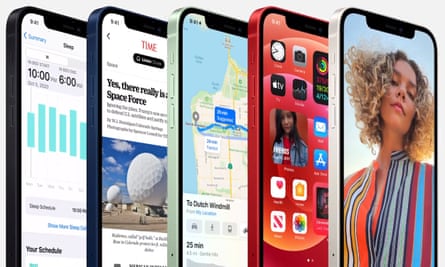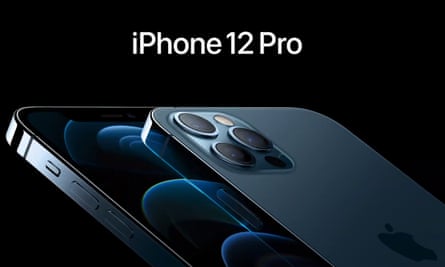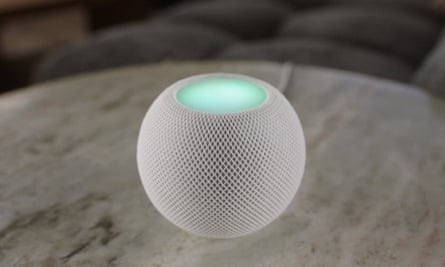Apple has unveiled its delayed iPhone 12 line of smartphones in a range of sizes with new designs and 5G connectivity.
Unveiled as part of a online-only event, which was pushed back by more than a month due to the Covid-19 pandemic, the new iPhones mark some of the biggest changes to Apple’s smartphones since the iPhone X in 2017.
The four new devices take a design cue from the iPhones 4 and 5 from 2013 and the newer iPad Pro and Air lines, with squarer metal sides and flatter profiles. All of the new iPhones also have Apple’s latest A14 Bionic processor, which recently debuted with the revamped iPad Air announced in September. They also all have Apple’s Face ID recognition system for unlocking the smartphones and will support 5G for the first time.
None of the new iPhones will ship with headphones or a power adapter, as a way of reducing the carbon footprint, but will contain a USB-C to Lightning cable in the box and will support faster wireless charging.
The new iPhones also have Apple’s new MagSafe system, which magnetically attaches accessories to the back of the phone, including a new MagSafe wireless charging puck.
iPhone 12

The mid-range model is simply called the iPhone 12 and is a direct replacement for Apple’s most popular phone from last year, the iPhone 11. It has a new and improved 6.1in OLED screen that replaces the LCD technology used on its predecessor.
The iPhone 12 has a new 12-megapixel dual-camera system on the rear with normal and ultrawide lenses and the TrueDepth selfie camera from Face ID on the front, all of which can now use Apple’s Night mode for low-light photos. The body of the phone is aluminium like its predecessor, while the back is glass.
The phone is 11% thinner than the previous model and has new Ceramic Shield screen glass technology, which has four times the drop performance of previous display glass for fewer smashed screens.
The iPhone 12 will cost from GBP799 in the UK or $799 in the US and will be available from 23 October.
iPhone 12 Mini

The smallest of the new Apple smartphones is the new iPhone 12 Mini, which has a 5.4in screen, making the phone slightly smaller than current iPhone SE but with a larger display filling the full front of the device.
It has the same dual-camera on the back and aluminium body design as the iPhone 12, including Ceramic Shield glass.
The iPhone 12 Mini will cost from GBP699 in the UK or $699 in the US and will be in stores on 13 November.
iPhone 12 Pro and Pro Max

The smaller high-end iPhone is called the iPhone 12 Pro and has a similar 6.1in OLED screen to the iPhone 12 – larger than the 5.8in screen of the iPhone 11 Pro from 2019.
The largest smartphone made by Apple will now be the new iPhone 12 Pro Max, which has a 6.7in OLED screen – 0.2in larger on the diagonal than the previous iPhone 11 Pro Max.
Both iPhone 12 Pro models have improved triple-camera systems on the back with ultrawide, normal and new telephoto lenses, plus a lidar-based depth-sensing scanner that can measure the distance of objects up to 5 metres away and aids in autofocus. A similar technology was launched on the iPad Pro in March and is designed for augmented reality experiences.
The body of the high-end iPhones will be made of stainless steel in highly polished finishes and with Ceramic Shield glass on the front. They also have a water resistance rating of IP68 for depths of 6 metres for 30 minutes.
The iPhone 12 Pro will cost from GBP999 in the UK or $999 in the US and will be available from 23 October. The iPhone 12 Pro Max will cost GBP1,099 in the UK or $1,099 in the US but will not be available until 13 November.
The launch of 5G-capable iPhones is expected to be a turning point in the roll-out of the fifth-generation mobile networks, in a similar manner to the first 4G-capable iPhone that spurred widespread adoption of the technology in 2012.
“If anyone can kickstart consumer demand for 5G, then Apple can,” said Paolo Pescatore, an analyst from PP Foresight.
HomePod Mini

Alongside the new iPhones, Apple has launched a new, smaller version of its HomePod smart speaker, powered by the Siri smart assistant, which it hopes will help it better compete with Google and Amazon’s dominant smart speakers.
The original HomePod sounded very good, but was let down by Siri’s limited capabilities and Apple’s restriction of music services to just its own.
The new HomePod Mini has the same S5 processor as the Apple Watch Series 5 to control playback and the sound generated by the speaker’s single down-firing driver and two passive radiators. The new speaker also has proximity detection for nearby iPhones equipped with Apple’s U1 chip and Siri can now differentiate between different people via their voice print.
The HomePod Mini will cost GBP99 in the UK and $99 in the US and ships on 16 November.
